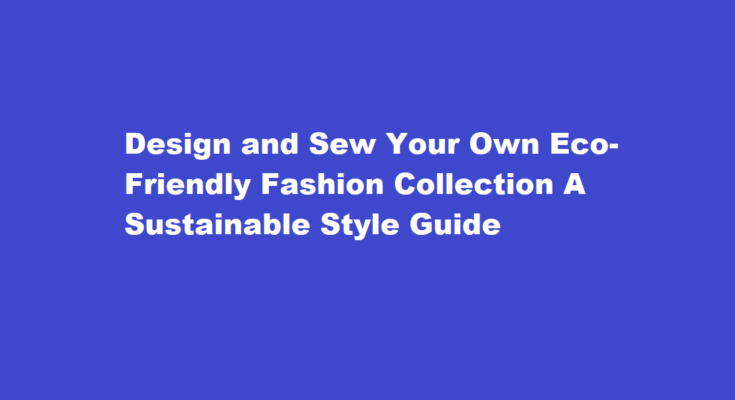Introduction
In a world increasingly concerned about the environmental impact of fast fashion, creating your own eco-friendly fashion collection is not only a creative endeavor but also a step towards sustainable living. By designing and sewing your clothes, you can control the materials used, minimize waste, and reduce your carbon footprint. In this guide, we will explore the essential steps to craft a unique and eco-conscious fashion collection that aligns with your values and fashion sensibility.
Define Your Vision
Before diving into the design and sewing process, it’s crucial to define the vision for your eco-friendly fashion collection. Consider your style preferences, inspiration, and the message you want to convey through your designs. Are you drawn to minimalism, bohemian flair, or urban chic? Understanding your design direction will guide your choices and ensure coherence in your collection.
Research Sustainable Fabrics
Choosing eco-friendly fabrics is the cornerstone of an eco-conscious fashion collection. Research and select materials with low environmental impact, such as organic cotton, hemp, Tencel, bamboo, recycled polyester, and peace silk. Avoid fabrics derived from non-renewable resources or harmful processes, like conventional cotton or synthetic fabrics.
Create Mindful Patterns
Mindful pattern-making is essential to minimize waste and optimize fabric usage. Explore pattern-making techniques that generate less offcuts, like zero-waste or modular designs. Consider how pattern pieces can be arranged to maximize fabric efficiency and reduce unnecessary scraps. Digital pattern-making tools can also help optimize layouts and reduce paper waste.
Embrace Slow Fashion
Adopting the principles of slow fashion is integral to creating an eco-friendly fashion collection. Slow fashion emphasizes quality over quantity and encourages consumers to cherish their garments, reducing the frequency of replacements. Design timeless pieces that transcend seasonal trends, ensuring long-lasting appeal and wearability.
Utilize Upcycling and Thrifting
Embrace upcycling by giving new life to old garments or textiles. Transform vintage pieces or second-hand finds into unique designs, reducing the demand for new resources. Thrift stores and online marketplaces offer a wealth of materials waiting to be reimagined in your eco-conscious fashion collection.
Eco-Friendly Dyeing and Printing
When adding color or patterns to your designs, opt for eco-friendly dyeing and printing methods. Natural dyes sourced from plants or eco-friendly pigments minimize water pollution and harm to the environment. Digital printing techniques use less water and produce fewer chemicals than traditional methods.
Ethical Production and Local Artisans
If you plan to collaborate with artisans or manufacturers, prioritize ethical and local production. Working with artisans ensures a fair wage and supports traditional craftsmanship. Local production reduces the carbon footprint associated with transportation and fosters a sense of community.
Minimize Packaging and Waste
Ensure your eco-friendly fashion collection extends its sustainability efforts beyond the garments themselves. Minimize packaging waste by using biodegradable or reusable materials for product packaging. Implement responsible practices throughout your supply chain to limit the overall environmental impact.
Educate and Advocate
Use your eco-friendly fashion collection as a platform to educate consumers about sustainable fashion and the importance of conscious consumption. Be transparent about your processes and materials, inspiring others to follow suit. Advocate for eco-conscious practices within the fashion industry and support initiatives that promote sustainability.
FREQUENTLY ASKED QUESTIONS
Is sewing your own clothes eco-friendly?
Ultimately, the decision to either make your own clothes or buy factory-made garments is a personal one. But no matter how you slice it, sewing your own clothes has some benefits over buying from a store. It’s environmentally friendly, cost-effective, and a great way to create a unique personal wardrobe.
What fabric is not eco-friendly?
Polyester, acrylic, rayon, nylon and conventional cotton are the least sustainable fabrics. Polyester is often used in clothing items, and most polyesters are non-biodegradable, so it can take up to 200 years to break down if it ends up in a landfill.
Conclusion
Designing and sewing your eco-friendly fashion collection is a rewarding journey that combines creativity and environmental responsibility. By incorporating sustainable fabrics, mindful patterns, and ethical production, you can lead the way towards a more eco-conscious fashion future. Let your collection speak volumes about your commitment to sustainable living and inspire others to make mindful fashion choices.
Read Also : Unleashing Your Inner Composer Creating Captivating Orchestral Music without Formal Training



